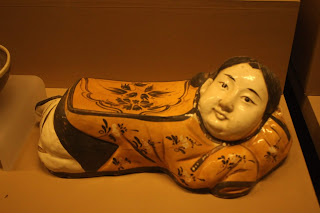I had heard a lot about the city of Xi'an, famous the world over for its Terracotta Warriors, which are often referred to as the Eighth Wonder of the World. So when I got a chance to visit China for the first time in 2013, I made it a point to go to Xi'an. My wife and I spent 4 days in this fascinating city.
Xi’an is the capital of China's Shaanxi province and is
a historical city with a population of over 6.5 million. Through its long
history, the town served as a capital to 11 dynasties, spread over 4,000
years. It used to be called Chang’an before the Ming
Dynasty. Xi’an became an important town in the 11th century BC with the founding of the Zhou Dynasty. The Qin Dynasty unified China
in the 2nd century BC and the capital was in the
vicinity of modern Xi’an. The first emperor, Qin Shi Huang, built the famous
Terracotta Army to protect his tomb. The City Walls around Xi’an were
constructed in the 14th century AD during
the Ming Dynasty.
With its rich historical heritage, Xi’an
has many tourist attractions that make it one of China’s most visited cities.
The top sites include the Terracota Army, the City Walls, the Bell Tower, the Drum Tower, the Great
Goose Pagoda and the Small Goose Pagoda. The one unique feature of the city is
that the city centre is enclosed within a 14 kilometer long rectangular wall,
that was built to fortify the city and save it from attack. The City Walls are
still intact.
The Terracotta Warriors were discovered by a
group of farmers in 1974. The army of over 7,000 soldiers dates back to 200 BC,
and the army was made to guard the tomb of Emperor Win Shi Huangdi, who is supposed to
have been buried in a hill over a kilometer away. The army is present in three
pits. Pit 1 is the largest, with close
to 6,000 soldiers in battle formation. After the discovery, restoration was a
major exercise, and each warrior has had to be individually restored carefully.
The spectacular site has been declared a UNESCO World Heritage Site.
 |
| Pit 1, Terracotta Warriors |
 |
| Pit 2, Terracotta Warriors |
The Bell
Tower lies right in the
centre of Xi’an, where the city’s four main streets converge. The Bell Tower stands on a brick platform. It
dates back to 1384, but was moved to its present location in 1582. The
structure has numerous bells, chimes and musical instruments. It used to house
a bronze bell that was struck every morning.
 |
| Bell Tower |
 |
| Interior, Bell Tower |
 |
| Bell, Bell Tower |
The Drum
Tower lies close to the
Bell Tower. It dates back to 1380. It has a collection of drums and other
musical instruments. Upstairs, visitors can get to see beautiful wooden
furniture.
 |
Drum Tower
|
 |
| Tang Drum, Drum Tower |
Xi’an’s City Walls are still intact, and
form a 14 kilometer rectangle around the city center. The walls are 12 meters
high. The City Walls date back to 1370, to the time of the first Ming Emperor, Hongwu. It is possible for
visitors to climb the steps and get on the walls, where they can walk or even
rent bicycles. A unique experience! My wife and I enjoyed our cycling experience along the City Walls.
 |
| South Gate, City Walls |
The Great
Goose Pagoda was built during the
Tang Dynasty in the 7th century AD. The pagoda was built in memory of Empress Wende. The pagoda’s tower
is 64 meters tall. It was built to store scriptures from India, brought by the
monk Xuanzang.
 |
| Great Goose Pagoda |
 |
| Hall of Sakyamuni, Great Goose Pagoda |
 |
| Hall of the God of Wealth, Great Goose Pagoda |
The Small
Goose Pagoda dates back to the 8th century AD. It was built to protect scriptures brought back from India. The
pagoda’s tower is 43 meters tall.
 |
| Small Goose Pagoda |
 |
| Bell Tower, Small Goose Pagoda |
The Shaanxi
History Museum has
a strong collection of ceramics, bronzes, jade pieces, gold and silver works
and calligraphy. Different periods from China’s long history are represented
here. The building itself has Tang Dynasty style architecture.
 |
| Green Glazed Dog (2nd Century AD), Shaanxi History Museum |
 |
Painted Female Figure Holding a Mirror (6th to 9th Century AD),
Shaanxi History Museum |
 |
Tri Coloured Horse (6th to 9th Century AD),
Shaanxi History Museum |
 |
| Zhongshan Grotto, Shaanxi History Museum |
 |
White Glazed Porcelain Pillow (11th Century AD),
Shaanxi History Museum |
 |
Bronze Ox Shaped Zun (10th Century AD),
Shaanxi History Museum |
The Banpo Museum stands on an excavated site of the Banpo tribe, dating back
6,000 years. The museum has a collection of weapons, tools, utensils and
skeletons of the Banpo tribe. There is also
an excavated village. Also exhibited are life size models of Banpo tribals, engaged in
different activities like hunting and fruit picking.
 |
| Fragments of Pots, Banpo Museum |
 |
| Banpo Man and Woman, Banpo Museum |
 |
| Banpo Hunters, Banpo Museum |
 |
| Skeleton of 2 Banpo Men, Banpo Museum |
The Muslim Quarter lies in the heart of
the city, behind the Drum Tower. The area is charming and well worth a visit,
with its narrow lanes and bazaars. It is a great place for souvenir shopping,
and to experience local food.
 |
| Silk Outfits, Muslim Quarter |
 |
| Terracotta Warrior Models, Muslim Quarter |
After the mega cities of Shanghai and Beijing, Xi'an certainly ranks as one of the most interesting cities in China. The Terracotta Warriors are undoubtedly spectacular, but the city also has a lot of other sites that warrant a visit too.
































































